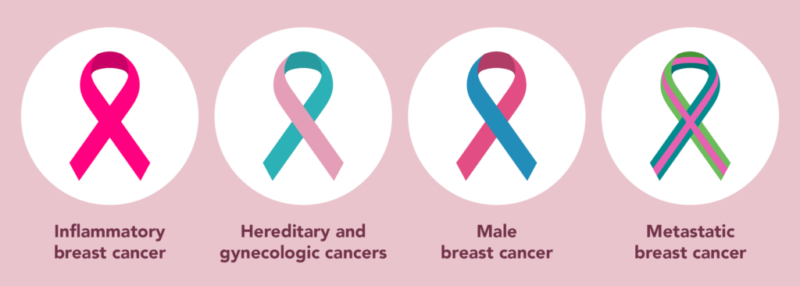Wanda Sykes is a renowned comedian and actress known for her sharp wit and unique voice in the entertainment industry. With a career spanning stand-up comedy, television, and film, she has become a trailblazer for women of color in comedy. Sykes’ career highlights include her work on The New Adventures of Old Christine, Curb Your Enthusiasm, and The Wanda Sykes Show. In 2011, Sykes publicly shared her battle with ductal carcinoma in situ (DCIS), a non-invasive form of breast cancer. breast cancer, emphasizing the importance of early detection.
After undergoing a double mastectomy, Sykes used her platform to raise awareness about the disease, stressing the significance of regular screenings and self-exams. Her openness about her health journey has played a crucial role in encouraging others to take preventive measures and seek early treatment, thus contributing to a wider conversation about breast cancer prevention.
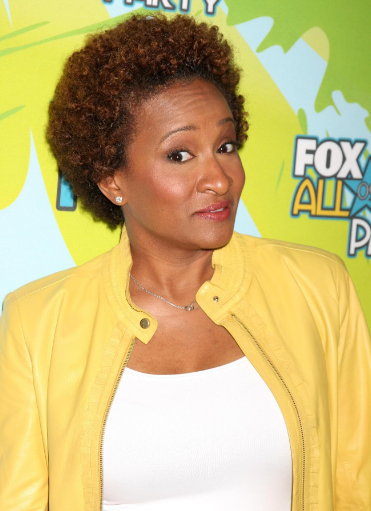
How Did Wanda Sykes Get Diagnosed with Breast Cancer?
Wanda Sykes discovered her breast cancer diagnosis during medical examinations related to a breast reduction surgery she underwent in 2011. Initially seeking the procedure to alleviate physical discomfort, Sykes was informed post-surgery that pathology reports revealed she had ductal carcinoma in situ (DCIS), a non-invasive form of breast cancer often referred to as “stage zero.” This early detection was pivotal, as DCIS can progress to invasive cancer if left untreated.
Symptoms
Wanda Sykes may have experienced no noticeable symptoms initially, as many cancers, including breast and cervical cancers, can develop without presenting any signs until they reach advanced stages. This underscores the critical role of routine medical screenings in early detection. Regular screenings can identify cancers at their earliest stages, often before symptoms arise, which significantly improves treatment outcomes and survival rates.
What Were Wanda Sykes Initial Reactions to His Diagnosis?
Upon receiving her cancer diagnosis, Sykes likely experienced a complex emotional response, common among many individuals facing such life-altering news. Initial reactions often include shock, fear, and anxiety, which can manifest as feelings of disbelief and overwhelming sadness. In interviews, Sykes expressed her thoughts on the emotional toll of the diagnosis and the decision to pursue surgery.In an interview with CBS News in 2012, Sykes said,
“I was just like, ‘What? Me? I’m too young for this.’ It was a huge surprise, and it kind of throws you off balance.”
What was the Prognosis?
Wanda Sykes was diagnosed with ductal carcinoma in situ (DCIS), which is classified as stage zero breast cancer. This stage indicates that the cancerous cells are confined to the ducts of the breast and have not invaded surrounding tissues. The prognosis for women diagnosed at this stage is generally excellent, as the cancer is highly treatable when detected early.
- Survival Rate: The 5-year survival rate for women with DCIS is nearly 100%, primarily because of early detection via mammograms and other screenings. This significantly improves treatment outcomes and long-term survival (American Cancer Society, 2023).
- Recurrence: Most women diagnosed at the DCIS stage do not experience recurrence after appropriate treatment, which often involves surgery and, in some cases, radiation therapy. Studies indicate that the risk of recurrence can be minimized with effective local treatments (National Cancer Institute, 2023).
- Comparison with Invasive Breast Cancer: In contrast, women diagnosed with invasive breast cancer at later stages face significantly lower survival rates and more extensive treatment regimens. The 5-year survival rate for women diagnosed with stage II breast cancer drops to about 93%, while stage III has an approximate 72% survival rate (American Cancer Society, 2023; National Cancer Institute, 2023).
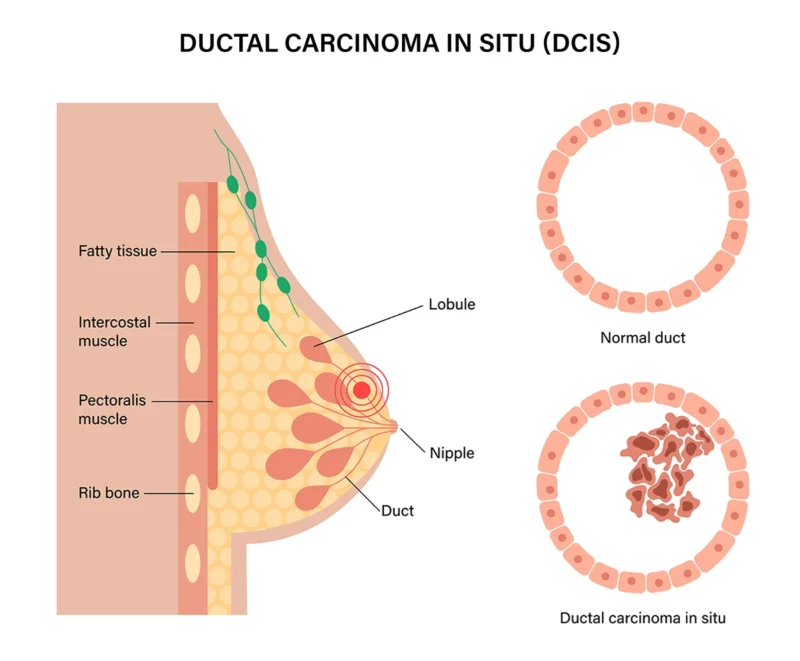
What Treatments Did Wanda Sykes Undergo?
Wanda Sykes opted for a double mastectomy after being diagnosed with ductal carcinoma in situ (DCIS), a non-invasive form of breast cancer. This decision stemmed from her desire to eliminate any risk of developing invasive breast cancer, especially given her family history of the disease. Sykes expressed her thoughts on the matter during an interview, stating,
“I had both breasts removed because now I have zero chance of having breast cancer.”
However, medical experts note that while a bilateral mastectomy significantly reduces the risk of breast cancer by about 90%, it does not completely eliminate it due to the possibility of residual breast tissue elsewhere in the body
Double Mastectomy
High-profile cases like Wanda Sykes and Angelina Jolie have brought attention to this surgical option, with both women opting for double mastectomies due to their respective cancer diagnoses and family histories. Their experiences underscore the importance of informed decision-making in breast health management and highlight the psychological and physical implications of such a significant surgical intervention. Sykes’ decision was influenced by several key factors:
- Genetic Predisposition and Family History: Sykes mentioned that her mother had breast cancer, which contributed to her decision to pursue a preventive approach. Given her family history, she felt a strong motivation to reduce the risk of cancer recurrence or future development in the opposite breast.
- Emotional and Mental Health: In interviews, Sykes discussed her fear of living with the constant anxiety of potential future breast cancer. By opting for the double mastectomy, she was able to regain a sense of control over her health and peace of mind.
- Medical Advice: After consultation with her medical team, including oncologists and surgeons, Sykes was informed that the mastectomy would significantly lower her risk of future cancer, especially considering the high risk of recurrence for her condition.
You Can Read Special Article by Oncodaily Bilateral Mastectomy and Breast Cancer Mortality
How Did Wanda Sykes Overcome Breast cancer ?
Wanda Sykes’ journey with breast cancer is not only a testament to her strength but also a demonstration of her resilience and unwavering commitment to her craft. Despite being diagnosed with DCIS (Ductal Carcinoma In Situ), a form of non-invasive breast cancer, Sykes continued to work as a comedian and actress while undergoing treatment and recovery, making her story even more inspiring for her fans and peers.

Support from Family and Friends
Wanda Sykes’ journey through cancer treatment was significantly supported by her family, friends, and broader support network, which played a crucial role in her emotional and physical recovery. Following her diagnosis of ductal carcinoma in situ (DCIS) and subsequent decision to undergo a double mastectomy, Sykes leaned heavily on her wife, Alex Sykes, and their twin children, Olivia and Lucas. The presence of her family provided both comfort and motivation during a challenging time.
Mental and Emotional Challenges
Wanda Sykes faced significant emotional challenges during her cancer treatment and recovery, particularly after being diagnosed with ductal carcinoma in situ (DCIS). The diagnosis came unexpectedly while she was seeking a breast reduction, which initially seemed like a straightforward cosmetic procedure. Upon learning about her cancer, Sykes acknowledged the fear and uncertainty that accompanied such news, stating,
“I had breast cancer. Yeah, I know it’s scary.”
Despite the gravity of her situation, she maintained her characteristic humor as a coping mechanism.Throughout her journey, Sykes used comedy to address her experiences with cancer, often infusing humor into her discussions about the disease. For instance, she joked about the irony of undergoing surgery for cosmetic reasons only to discover cancer:
“I had real big boobs and I just got tired of knocking over stuff.”
How Did Advocacy and Public Awareness Help?
Wanda Sykes has effectively used her platform as a comedian and actress to raise awareness about breast cancer prevention and early detection, particularly following her own diagnosis of ductal carcinoma in situ (DCIS). After undergoing a double mastectomy in 2011, Sykes became an outspoken advocate for breast health, leveraging her visibility to educate others about the importance of regular screenings and self-exams.
Public Speaking and Advocacy
Sykes’ advocacy efforts are crucial given that one in eight women will be diagnosed with breast cancer in their lifetime. By sharing her personal journey publicly, she has helped destigmatize discussions around breast cancer and encouraged women to prioritize their health. During interviews, such as her appearance on The Ellen DeGeneres Show, Sykes candidly discussed her diagnosis and treatment choices, providing insights into the emotional challenges of facing cancer while maintaining humor. She remarked on the irony of discovering cancer during a routine breast reduction surgery, saying,
“I was very lucky because DCIS is basically stage zero cancer… but cancer is still cancer”
Collaborations with Health Organizations
Wanda Sykes has actively collaborated with several health organizations and cancer research institutions to raise awareness about breast cancer prevention and early detection. One of her most notable partnerships was with Stand Up To Cancer (SU2C) and the Safeway Foundation. In 2014, Sykes joined forces with these organizations to launch a campaign aimed at increasing public awareness and funding for breast cancer research. This initiative included public service announcements (PSAs) featuring Sykes, emphasizing the importance of supporting research that could lead to more effective treatments for breast cancer. The campaign coincided with National Breast Cancer Awareness Month and was designed to encourage donations at Safeway stores across the U.S., where customers could contribute directly to breast cancer causes.
As a breast cancer survivor, I am honored to join Stand Up To Cancer and The Safeway Foundation in this critical initiative… Together we hope to raise funds and create awareness toward cancer research”
What Is Wanda Sykes Life Like After Cancer?
Sykes resumed her comedic career shortly after recovery, continuing to perform and engage with audiences. In interviews, Sykes noted that keeping up with health appointments can be a struggle, humorously admitting,
“I’m sure I’m overdue for an oil change and a teeth cleaning already.”
This candidness highlights the importance of regular check-ups and self-care in her ongoing health management. Wanda Sykes’ journey post-treatment illustrates how she balances her career as a comedian with ongoing health awareness efforts. Her ability to maintain a sense of humor while addressing serious topics has made her a relatable figure in the fight against breast cancer.
Ongoing Health Challenges
What Causes Breast Cancer?
Breast cancer is influenced by a combination of genetic, hormonal, and environmental risk factors. Breast cancer is the most commonly diagnosed cancer in women worldwide, with an estimated 2.3 million new cases in 2020 (World Health Organization, 2020). The risk of developing breast cancer increases with age, with most cases diagnosed in women aged 55 and older (American Cancer Society, 2022).
Genetic and Hormonal Factors
Genetic mutations, particularly in the BRCA1 and BRCA2 genes, significantly increase breast cancer risk. Women with a BRCA1 mutation have a 55-65% chance of developing breast cancer by age 70, while those with a BRCA2 mutation have a 45% risk (National Cancer Institute, 2021). Family history is also important; having a first-degree relative with breast cancer can double a woman’s risk (American Cancer Society, 2022).Hormones, especially estrogen, play a critical role in breast cancer development. Prolonged estrogen exposure, such as starting menstruation before age 12 or entering menopause after age 55, can elevate risk (World Health Organization, 2019). Additionally, hormone replacement therapy (HRT) may increase breast cancer risk by 26% (JAMA Oncology, 2019).
Lifestyle and Environmental Factors
A variety of factors influence breast cancer risk, including diet, alcohol consumption, physical activity, environmental exposure, and radiation. Diets high in saturated fats and low in fruits and vegetables are linked to an increased risk, with obesity, particularly post-menopause, further raising the risk (American Cancer Society, 2022). Regular alcohol consumption, especially more than one alcoholic beverage daily, increases breast cancer risk by 20-25% (National Cancer Institute, 2021).
A lack of physical activity contributes to obesity and hormonal imbalances, further elevating risk, while regular exercise provides protective benefits. Environmental pollutants, such as pesticides, have also been associated with a higher risk (Environmental Health Perspectives, 2019). Additionally, previous radiation exposure to the chest area, particularly during youth, is a well-established risk factor (World Health Organization, 2019).
How Can Breast Cancer Be Prevented?
Regular mammograms and other screening methods are vital for the early detection of breast cancer, significantly improving treatment outcomes and survival rates.In addition to regular screenings, specific lifestyle changes can significantly lower the risk of developing breast cancer.
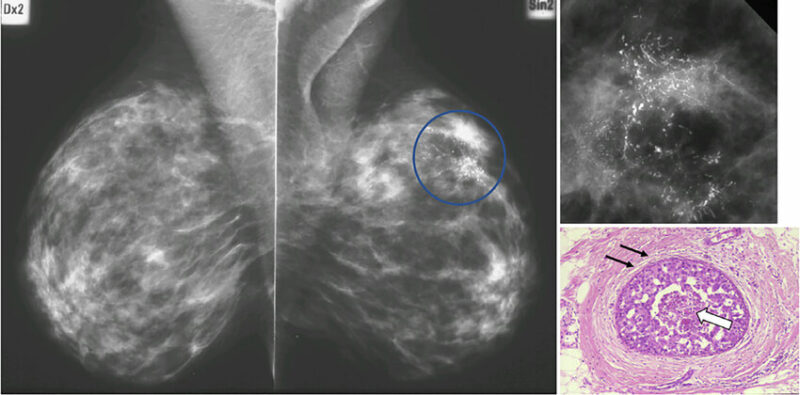
Ductal carcinoma in situ (DCIS) visible on the mammogram in the upper part of the left breast as an area with polymorphic calcifications with a linear/branching arrangement following the ducts (magnification, top right). The histological image, bottom right, clearly shows the cancer is confined within the basal membrane (black arrows), with necrotic cells in the center of the duct (white arrow). The necrotic areas calcify and give rise to the characteristic mammography image (Image courtesy, Skåne University Hospital Malmö).
Regular Screenings and Early Detection
BRCA mutations in the BRCA1 and BRCA2 genes significantly raise the risk of breast and ovarian cancers, with women facing up to an 85% lifetime risk for breast cancer and 40-60% for ovarian cancer. Preventive options include increased screening, risk-reducing surgeries like prophylactic mastectomy and salpingo-oophorectomy, medications, lifestyle changes, and genetic counseling.
Many individuals opt for surgeries to lower their cancer risk, and the National Cancer Institute outlines the benefits of these options. Additionally, some may choose chemoprevention with medications such as tamoxifen or aromatase inhibitors, which can reduce breast cancer risk, as noted by the Mayo Clinic.
Women aged 40 and older should have annual mammograms, as early detection through mammography can identify breast cancer before symptoms develop, leading to less invasive treatments. The American Cancer Society reports a 5-year survival rate of 99% for localized breast cancer, compared to just 29% if diagnosed at a later stage (American Cancer Society, 2021). Regular mammography can reduce breast cancer mortality by approximately 15-30% among women aged 40-74 (U.S. Preventive Services Task Force, 2016). Prioritizing screenings allows women to catch breast cancer early, resulting in more effective treatments and better outcomes.
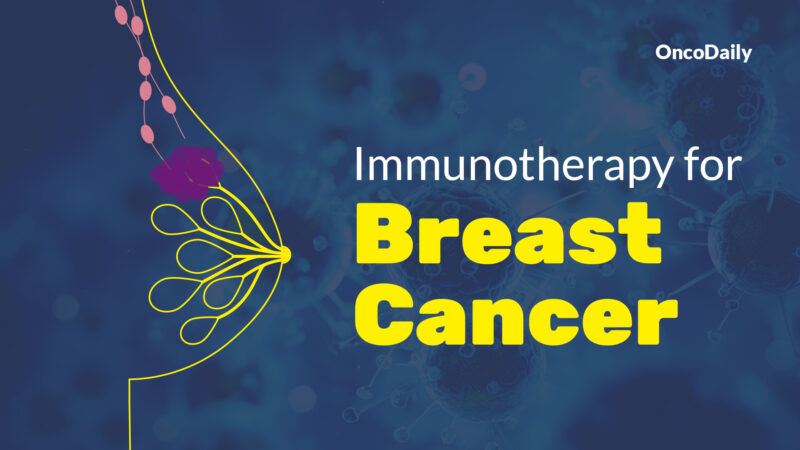
You Can Read Special Article by Oncodaily on Novel Treatments for Breast Cancer: Immunotherapy
Lifestyle Changes
A healthy diet is vital for reducing breast cancer risk, focusing on fruits, vegetables, whole grains, and lean proteins. Research indicates that women with a diet high in fruits and vegetables have a 20% lower risk of breast cancer (American Institute for Cancer Research, 2018). Regular exercise is also important; at least 150 minutes of moderate aerobic activity weekly can reduce breast cancer risk by about 25% (National Cancer Institute, 2020).
Limiting alcohol intake is crucial, with recommendations of no more than one drink per day. Consuming two to three drinks daily increases the risk of breast cancer by 20-30% (American Cancer Society, 2021). Maintaining a healthy weight is essential, as obesity raises the risk by 30-60% in postmenopausal women (World Health Organization, 2020). Lastly, avoiding tobacco is key; women who smoke are 25% more likely to develop breast cancer compared to non-smokers (Cancer Research UK, 2019).
FAQs
What type of cancer did Wanda Sykes have?
Wanda Sykes was diagnosed with ductal carcinoma in situ (DCIS), which is a non-invasive form of breast cancer.
Why did Wanda Sykes opt for a double mastectomy?
Sykes chose to undergo a double mastectomy after her diagnosis because of her family history of breast cancer and her desire to eliminate any risk of developing invasive breast cancer in the future. She stated, “I had both breasts removed because now I have zero chance of having breast cancer”
How did Wanda Sykes discover her breast cancer?
Sykes discovered her breast cancer during a routine breast reduction surgery. After the procedure, pathology results revealed the presence of DCIS in her left breast
What has Wanda Sykes said about her experience with cancer?
In interviews, Sykes expressed that while she felt lucky to have caught the cancer early, she recognized that “cancer is still cancer.” She humorously noted her struggle to keep up with health appointments, saying, “I’m sure I’m overdue for an oil change and a teeth cleaning already”
Has Wanda Sykes been involved in any advocacy for breast cancer awareness?
Yes, Sykes has actively participated in campaigns promoting breast cancer awareness and early detection. She has collaborated with organizations like Stand Up To Cancer and has done public service announcements (PSAs) encouraging women to prioritize regular screenings and self-exams
How has surviving breast cancer affected Wanda Sykes’ perspective on life?
Surviving breast cancer has deepened Sykes’ appreciation for life and the support from her family and friends. She often uses humor as a coping mechanism and emphasizes the importance of resilience in facing life’s challenges
Is Wanda Sykes currently healthy after her treatment?
As of now, Wanda Sykes is reported to be cancer-free and continues to advocate for breast health awareness while returning to her career in comedy
What is ductal carcinoma in situ (DCIS) and how is it treated?
DCIS is a non-invasive breast cancer where abnormal cells are confined to the milk ducts. Treatment typically involves surgery (lumpectomy or mastectomy) and may include radiation therapy and hormone therapy.
What are the survival rates for DCIS?
The survival rate for DCIS is nearly 100% at 10 years, making it highly treatable. Most patients can be cured with appropriate treatment, though regular follow-up care is essential to monitor for recurrence.
What controversy did Wanda Sykes face for her comments about Rush Limbaugh?
At the 2009 White House Correspondents’ Dinner, Wanda Sykes faced backlash for her sharp jokes directed at conservative radio host Rush Limbaugh, including a controversial remark wishing for his kidneys to fail. This sparked debate over the appropriateness of her humor in that setting and drew significant media attention.
Written by Aharon Tsaturyan, MD

